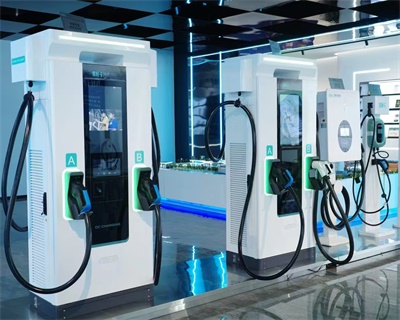Workplace EV Charging Solutions, Charging Stations
To adapt to the new era of mobility, many companies are now offering electrification for their fleets. By offering EV charging at the workplace, employers can make it easier and more economical for employees to drive EVs.
From 2013 to 2025, the U.S. Department of Energy (DOE) Workplace EV Charging Challenge collaborated with organizations committed to providing EV charging stations for employees. Many of the best practices, lessons learned, tools, and templates offered here are based on the achievements of Challenge partners.
The City of Boston’s Operations Guide: Starting a Workplace EV Charging Program (PDF) provides further information on planning and managing workplace charging, including sample employee charging etiquette handbooks.
Incorporate EV charging into workplace benefits
Adopt a simple, manageable solution that supports your sustainability objectives.
Set your workplace apart by demonstrating your commitment to sustainability and enhancing your benefits package.
Manage station access, pricing, and energy usage across all locations with one comprehensive cloud-based platform.
Deliver reliable and convenient charging that grows with your business, while keeping costs in check.
Lower GHG emissions, fulfill company sustainability objectives, and highlight your achievements to important stakeholders.
Strategic placement of workplace EV charging stations
Given the rising demand for EVs, many companies are contemplating adding charging stations. However, the decision is complex. How many chargers are required, and which type should be chosen? What are the reasons for installing them? Is there public funding available to assist with the costs?
For maximum effectiveness, workplace EV charging stations should be installed in easily accessible, high-visibility areas. Ideal locations include:
- Close to electrical infrastructure to minimize installation costs
- Near building entrances or in prominent parking areas
- In covered areas such as a parking garage or beneath solar canopies for weather protection and to leverage renewable energy sources
- Near visitor parking to accommodate clients and guests
- Adjacent to common areas or break rooms
Level 2 (L2) charging stations offer great flexibility in placement. They can be conveniently installed near office entrances, making them easily accessible and visible to both employees and visitors. Alternatively, L2 chargers can be integrated into existing parking facilities that already have electrical infrastructure, such as parking garages or covered lots. This flexibility not only enhances accessibility but also reduces installation costs by utilizing areas that are already equipped with the necessary electrical supply.
With the rising popularity of electric vehicles, it’s crucial for businesses and property owners to plan for future demand. Selecting locations that facilitate easy expansion, such as installing conduits for additional parking spaces during the initial phase, will ensure that growth can be accommodated efficiently as EV adoption increases.
Traffic flow is another important consideration. It is important to avoid placing chargers in locations where they could cause congestion or block emergency vehicle traffic. Companies can follow established best practices for parking lot EV charger installations.
By carefully considering these aspects, businesses can develop an EV charging infrastructure that meets the current needs of their EV-driving employees while being flexible enough to meet future needs.

Is a workplace EV charger a taxable benefit?
Workplace EV charging is not considered a taxable benefit for employees. As of 2024, the Internal Revenue Service (IRS) generally classifies workplace EV charging as a non-taxable de minimis fringe benefit. This means that its value is so low that accounting for it would be unreasonable or administratively impractical.
Therefore:
(1) Employees do not incur any additional tax liability for using workplace EV charging stations.
(2) Employers do not receive direct tax advantages or exemptions for providing this service.
While there may be no direct tax benefits, businesses might still benefit from other incentives for installing EV charging stations. The National Electric Vehicle Infrastructure (NEVI) Formula Program, which primarily focuses on establishing a national network of commercial EV chargers along designated corridors, could potentially benefit some workplaces if they meet specific criteria and location requirements. Additionally, state and local governments may offer their own incentives or grants for businesses installing EV charging infrastructure. Companies should consult with tax professionals to understand all potential benefits and implications specific to their situation and location.

workplace EV charging station options
For most workplaces, Level 2 (L2) electric vehicle chargers offer a practical and affordable solution. These chargers operate at 240V and can provide approximately 25 miles of range per hour. This means that over the course of an 8-hour workday, employees can add up to 200 miles of range to their vehicles – more than enough for most daily commutes.
However, DC fast chargers (Level 3) are becoming increasingly popular in workplace and commercial settings for their ability to charge vehicles more quickly. These chargers can efficiently serve employees and customers. High-turnover distribution centers or businesses with a mix of vehicles can choose a combination of L2 and DC fast chargers to meet different charging needs.
Although DC fast chargers consume more power and are more complex to install and maintain, they can bring significant benefits to businesses in a variety of industries. For example:
(1) Corporate campuses can attract and retain employees by offering fast charging, especially those with long commutes.
(2) Retail venues such as shopping malls, hotels, and restaurants can increase customer traffic and revenue by providing convenient fast charging.
(3) At transportation hubs such as airports and train stations, fast charging stations can enhance the travel experience for passengers and rideshare drivers.
(4) Automotive companies such as car dealerships can showcase the advantages of electric vehicles by offering fast charging to customers.
(5) Logistics and distribution centers, especially those with fleets of electric trucks, can minimize downtime and optimize operational efficiency by installing DC fast chargers in loading dock areas.
Similarly, healthcare and educational institutions can also benefit from offering fast charging to employees, students, and visitors, creating more convenience while supporting sustainable development.

Can a commercial workplace EV charging station be profitable?
Assessing the financial viability of installing electric vehicle (EV) charging stations in the workplace requires a comprehensive look at both tangible and intangible financial advantages. Although these facilities might not directly produce income, they can substantially impact a company’s profitability in numerous ways.
One crucial aspect is employee retention; providing EV charging facilities can minimize staff turnover and the related expenses of recruitment and onboarding new employees. Moreover, the presence of workplace charging stations can bolster a company’s reputation, drawing in clients and partners who value environmental sustainability. This enhanced corporate image could result in more business opportunities and collaborations, thereby indirectly increasing profitability.
Several companies are considering making their charging stations accessible to the public. They implement a tiered pricing strategy where employees enjoy free or reduced-cost charging, while the general public pays standard rates. Regarding security and deterring unauthorized use, many workplaces opt for access controls instead of completely deactivating the stations after hours. This can involve key card systems or mobile applications that permit only authorized individuals to use the chargers, ensuring exclusive benefits for employees or approved users while maintaining 24/7 availability.
Reasons workplace EV charging might be profitable:
- Enhanced corporate image
- Employee retention
- Increased property value
- Potential public revenue
- Competitive advantage in hiring
- Tax incentives and grants
Businesses can choose RUIHUA brand L2 and DC fast charging equipment made in China for installation in the workplace. We have worked with several North American companies to provide charging services for employees and visitors, including charging facility installations in commercial retail parking lots and gas stations. Contact RUIHUA today to learn more about our EV charger options for the workplace and environment.
RUIHUA is the largest EV charger manufacturer in China, providing top-of-the-line commercial EV charging stations for locations including workplaces, office buildings, and executive campuses.





